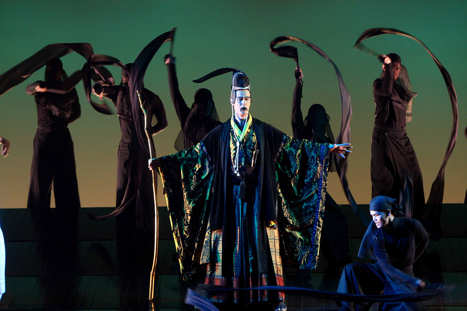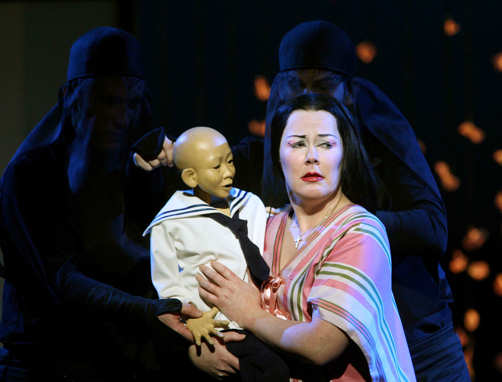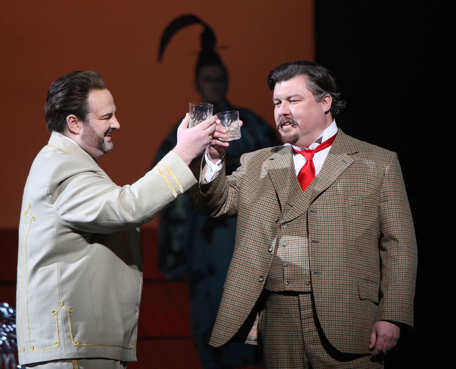Other Links
Editorial Board
- Editor - Bill Kenny
- London Editor-Melanie Eskenazi
- Founder - Len Mullenger
Google Site Search
SEEN
AND HEARD OPERA REVIEW
Puccini,
Madam Butterfly:
Soloists, chorus and orchestra of English National Opera conducted
by David Parry. London Coliseum 31.1.2008 (JPr)
Fresh from the selective revisionism of
Die Zauberflote at Covent Garden I couldn't
help remembering how when Madama Butterfly was revived at
Covent Garden early in 2007 those keeping an eye out for anything
non-PC damned it because of its racial stereotypes.
While this is undoubtedly apposite to this opera, I have
also always found the toasts, however ironic Puccini might
intentionally or otherwise have been, to the greatness of the
America (or ‘God’s America’ at one point) also particularly
irksome. However it is the acceptance of the ‘pleasures’ of sex
tourism that is particularly worrying if dwelt on too long in this
opera. The
acceptability of underage sex is made clear in Act I where one might
hope common sense would prevail and something like ‘Make love to
me gently as if I were a baby’ would be excised from David Parry’s
translation. And yet again there is rampant misogyny as Pinkerton
sings ‘She babbles on like women everywhere you go’.
Anthony
Minghella's Olivier award-winning production returns to the London
Coliseum after a couple of stagings at the New York Metropolitan
and although Minghella himself is absent, in the hands of
his wife, the production’s associate director and choreographer
Carolyn Choa, the revival stays close to home.
There are undoubtedly some wonderfully evocative and atmospheric
moments; in Act I dancers flick out black ribbons as a background
to the turmoil The Bonze creates. At the start of Act II, panels
are used ingeniously to take Pinkerton from his ‘bride’ and then
there is the opening ballet at the start of Act II Part Two with a
puppet Cio-Cio-San dreaming of her life together
with Pinkerton, along with origami birds (robins?) on sticks. Another
scenic masterstroke came after
the music stopped and Judith Howarth took her curtain call rising
in silhouette against red lighting (by Peter Mumford) reminding me
of some huge insect, not necessarily a butterfly.

Paul Whelan as the Bonze with Bunraki puppeteers
While I am not propounding gutting opera
libretti to make them more acceptable for twenty-first
century audiences, I am highlighting an
inconsistent approach to these matters. Nowhere else in theatre
- where an actor of a suitable ethnic background must be cast as
Othello these days and Fagin has become - well who knows what,
but certainly not Jewish - would Judith Howarth, on a number of
counts, get to portray a 15-year-old. So let’s raise at least two
cheers for the world of opera because it is stuck in a timewarp: in reality these works are what they are and belong to the
time they are written. But what's for sure though is that Madam
Butterfly, despite its music, has never been merely a romantic love story.

Judith Howarth as Madam Butterfly
There is a black lacquered box like set (by Michael Levine) and
above the stage a huge mirror to show what is happening 'behind the
scenes'. The moveable wall panels making up Cio-Cio-San's
house are reminiscences of Graham Vick’s 1984 iconic ENO
production that went someway to undercutting the opera’s
controversial moment with scenic counter-arguments. These have a multitude of uses
including providing entrances for characters or stage furniture.
Basically, we seem to be looking at a very large
display case, peering in at the latest exotic exhibit.
Minghella has been attracted by making the production as ‘authentic’ as
possible. So Cio-Cio-San is ultimately a victim of the exquisite
rituals of Japanese culture though she would never in reality kill
herself the way she does. There are hectares of silk on stage of
almost every colour known to (wo)man or Zandra Rhodes, in the
kimonos, obis, parasols and fans from costume designer Han Feng.
Cio-Cio-San says those crude ‘baby’ words and Gwyn Hughes Jones’s
bulky Pinkerton is after his money’s worth but that's all okay
because down comes a pretty cherry blossom curtain and there is a
‘ballet’ involving 9 paper lanterns -, and you realise that is
supposed to be no more than a romantic duet when actually it is so
much more. So everything looks very good without making the
audience care enough about what they are being shown. Most of what
this opera really needs is already in the score, the hints of Wagner in Act III
seem deliberate as if to underline the drama. Throughout, Puccini
shows a mastery of ceremonial moments and intimate ones, the joy
of togetherness and the pain of desertion and this is something
that Minghella does not quite match.

Gwyn Hughes Jones as Pinkerton / Ashley Holland as Sharpless
Unfortunately, the mention of ‘puppet’ brings me to the main
weakness of the staging and the appearance of Sorrow,
Cio-Cio-San’s son as another Bunraku puppet, despite being
wonderfully and traditionally manipulated by up to three puppeteers
(of the Blind Summit Theatre) in full view. The puppet seemed too
small and looked eerily too much like William Hague to be other
than a distraction. This device eliminates any real emotional interplay
between a mother and her son; unlike the Vick production where the child was undoubtedly Japanese
and one of the most significant moments where Vick
challenged Giacosa and Illica’s original libretto. It is not
really possible to pity a wooden doll nor can it make you want to rush
t0 the stage to prevent the mother committing suicide. Where the
evening should be at its emotional height we were absorbed by watching
the puppet
for goodness sake!
There was not enough emotion in the pit either during Act I when David Parry’s
Puccini was too unidiomatic and carefully paced. The music gained the
freedom and intensity necessary only in the final part of Act II
despite secure playing from the orchestra and well coached singing
from the chorus. This is a score that benefits from a
free use of rubato and the rough-edges that attacking the music
dramatically can produce but here, sheer volume often overpowered the
soloists - which in some cases that may have been the individual
singer’s own fault. Christopher Gillett’s Goro and Paul Whelan’s
Bonze were not at their best and it was unclear what language the
latter was singing in. Of the younger generation of singers, William
Berger and Madeleine Shaw seemed to make more of their roles as
Yamadori and Kate Pinkerton than Puccini had in mind for them so they may
people to watch develop in future years. Suzuki probably had the
best voice of the major singers and gave a rounded portrayal of
this pivotal role, although slightly unbalancing the quartet of
principals as a result. Ashley Holland did not project well as
Sharpless and some words were lost; he was a very bluff and
underplayed consul. Gwyn Hughes Jones had the slow moving bulk of
John Wayne in John Huston’s The Barbarian and the Geisha
but had little charisma and the voice, bright and secure though it
was, lacked the Italianate ‘sob’ that role demands.
Finally, Judith Howarth was the replacement for Mary Plazas who was
the original Cio-Cio-San in this production. Much was made I
thought at the time, of needing a singer who was ‘so very tiny’ as
the translation says this character should be, yet here we had the
very experienced Miss Howarth. She acted very gamely and always
tried to be true to the character, but it was difficult to suspend
belief and think of her at all as a teenager. From a purely vocal
point of view, after a botched climactic high D flat after her first
entrance, her singing exhibited a mature cultured artistry, elegant
tone and phrasing though perhaps lacking some freshness and
precision. The depth of her character’s vulnerability
and despair was plain to see during Act II which was where Miss
Howarth was at her best. Even then, despite her best efforts she just
did not raise the dramatic temperature high enough to make me care what
became of her in the way a number of sopranos at ENO have done in the
past.
Photos © Alastair Muir
Back
to Top
Cumulative Index Page
